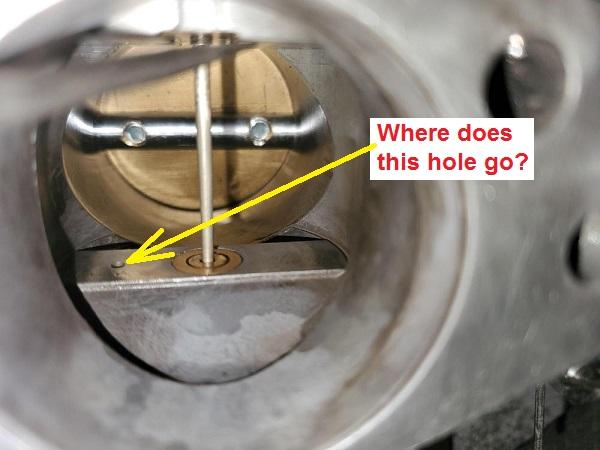Everything posted by Captain Obvious
-
Perplexing "FUEL" light malfunction
Steve, LOL. No. I'm talking about the balancing act between the changing resistances of the thermistor and the bulb filament. I measured the filament resistance of a couple of the 3.4W bulbs from the Z. When cold, the resistance is about 5.4 Ohms. If you calculate the power that bulb will consume when connected to a 12V source, you get about 31 Watts. 31 Watts!!! And the current that would flow through that 5.4 Ohm "resistor" would be about 2.4A!! However, it doesn't work that way. The resistance of the bulb filament increases significantly when it heats up and glows. That's what I meant a while ago about the bulb being a PTC. To show this effect, I connected the bulbs to a 12V source and measure the current draw while the bulb was lit. It was 220 to 240 mA. And if you back calculate the filament resistance, you find that the resistance has increased about tenfold from 5.4 Ohms to about 50 Ohms. So as the resistance of the thermistor decreases (allowing more current flow), the resistance of the bulb goes up (disallowing more current flow). That's the balancing act I was talking about. It's just a light bulb and a thermistor and it's giving me a headache. HAHA!!
-
Perplexing "FUEL" light malfunction
I want to hear Steve's explanation about the whole balancing act and competing factors here... But in any event, it sounds like you DO have the correct bulb in there, so I think we're back to the thermistor.
-
Perplexing "FUEL" light malfunction
I had originally thought there was simply some dyslexia going on here, but now I'm not so sure... The original bulb spec is 3.4W, but the one in your pic (and part number) appears to be 4.3W instead. If that bulb really is 4.3 instead of 3.4, that might be part of the problem. Do you have another (known to be correct) bulb you can toss in there just to see what happens? My original bulbs were Toshiba A12V3.4.
-
Perplexing "FUEL" light malfunction
Ha!! Made you look! So the only thing they can muster is "It's resistance is different". Not much help! The whole thing is a balancing act... The thermistor in the tank is a NTC and the bulb filament is a PTC. You need the current through the thermistor high enough to achieve the desired power dissipation such that there is self heating when not submerged in fuel, but never enough power to damage it. And when the thermistor does heat up and it's resistance drops, you need the resistance low enough to get the bulb filament to glow.
-
Perplexing "FUEL" light malfunction
I got no silver bullet. The only explanation I have is what you already mentioned... Sounds like the thermistor is not quiiiiite right for the application. CLOSE, but not enough headroom for tolerances and environmental stressors like ambient temp and system voltage. And as Zed mentioned, why it only happens when the engine is running is probably because the system voltage is higher then. That extra volt-n-a-half matters. Thermistors come in all sorts of base resistances and with all shapes different curves. For this application, you want one with a "knee" in the curve as opposed to linear, and you want the knee to be at the correct temperature. I'm thinking that it's too close to the limit most of the time, and the combination of ambient temperature and system voltage (when the engine is running) puts it over the edge. @Dave WM, Did you find any specs at all about the thermistor? Anything at all? I didn't look at any of the FSM's, but I bet you did. I wonder what thermistor ZCD picked for their unit. And why.
-
Suspension Bushing Replacement
Haha!! Could be! I'll crawl back under my same as it ever was rock now.
-
Suspension Bushing Replacement
@siteunseen, what's the deal with the goofy new pics? You get a new toy or subscription to something?
-
Clutch fork throw
This recent thread: https://www.classiczcars.com/forums/topic/64260-240z-hls-30-42277-restauration-colombia-southamerica/?do=findComment&comment=603098 Includes some pics of what looks like the same transmission: Kinda dark inside the bell housing to get a real good look at the pivot ball post, but maybe @Mazinga Z would be willing to take a closer pic for you.
-
Clutch fork throw
I find the parts documentation confusing. Even though the new pivot number says no interchange, note that it DOES list that it superseded the old number. I did some internets searching for info on the part numbers and turned up very little about the old one. I agree that it would be very enlightening to see a pic of the old pivot next to the new one.
-
Front SU Carb pulling in a TON more air than the rear - Help...
So it's a bummer when your old un-rebuilt carbs are in better shape than "rebuilt" ones you paid (I assume) good money for. That throttle shaft is a disaster. I kinda wonder what other issues are lurking with those "rebuilt" carbs. I guess if they work OK (the rear one at least), one could assume any other mishandlings are minor enough to keep using them. Only suggestion would be to make sure you check the float bowl levels.
-
R180 diagnosis S3019500
That's a good video. Thanks for that. So good luck with it, regardless of which way you decide to proceed.
-
What I Did Today
Haha! Well played!
-
Front SU Carb pulling in a TON more air than the rear - Help...
And please tell me you weren't the one that painted the carbs, right? That was the PO?
-
R180 diagnosis S3019500
LOL. I hear ya. But looking back at your pic, you've already cleaned off the grease AND pulled the rear cover off, right? No chunks of metal came out? No missing or damaged looking teeth? Nothing looks blued from heat? I still say Put it in and run it. If you're energetic, put new seals on the output shafts first. I think they're the easy ones, right?
-
Sealing an oil pan
"Collector".
-
Sealing an oil pan
Bingo. Thanks Patcon. So the bottom one in my pic is turbo. The overhang shields the oil line out the side of the pan.
-
R180 diagnosis S3019500
My completely unsupportable opinion? It's fine. Clean the grease off put it in the car and run it.
-
Front SU Carb pulling in a TON more air than the rear - Help...
Wow!! That's some fine PO workmanship you got right there! Yeeesh! So when you said you swapped over to the old carb... Are you thinking you're going to repair the PO hammered one, or just keep running the other? Is there something wrong with the other one that made you want to run this one instead? And thanks for the pics of that mystery hole, but unfortunately I'm still unclear where that hole goes. It's definitely a 72 specific thing and unfortunately I don't have a pair of those here to poke around with. Thanks again though!
-
What I Did Today
No, why? Is that what that motor runs on?
-
What I Did Today
Well I'm satisfied now. I was hoping the story behind the pic was as good as the pic itself, and you came through my friend!
-
Clutch fork throw
AAAAAAAAAAA!!!!! I am not happy. This is NOT the smoking gun I was waiting for!!! Seriously though. I hope it works and you can move on with the project!!
-
78 280Z - no injector pulse
And I would suggest that investigation be done outside of PM conversations. Investigations like this benefit other users in the future who are looking for solutions to similar problems.
-
Front SU Carb pulling in a TON more air than the rear - Help...
As Patcon mentioned, the "hole" you are seeing in that pic is simply the jet needle dropped down out of sight. It's normal operation if the choke is on or if the nozzle has been adjusted down to affect the fuel ratio. It's not the problem here. But while I'm in here there are a couple things I wanted to ask about... First, what's the deal with that one carb with all the gouges and marks on the venture bridge? That thing is hammered!! Like the slide piston was stuck down at one point and someone stuck a screwdriver in there and tried to pry it up or something?? Probably doesn't make much functional difference, but those marks really show evidence of mistreatment in the past. Other question is... There are small (1/8 inch-ish?) holes in the bridges that are intentional. I assume they are 72 specific. Where do those holes go? :
-
Sealing an oil pan
Site, the shield in your pic is the top two in my collection. It's the only one that pushes inward towards the front to follow the contour of the pan. The others in my pic don't do that. AZDatsun, My 77 also has that top two design as well, so with your data point and Site's, it appears that style was used at least on 77, 78, and 79. According to the documentation, all the 240, 260, 280 used the same part number for that support - 11123-N4200. There is another part number listed for the 240 and 260- 11123-N3300, but I suspect that was for the very early cars and was quickly superseded by the later number. So they may have changed the shape of that heat shield on different years, but they never considered the change to be significant enough to warrant a change in part number? Form, fit, and function, they are all interchangeable apparently? I have no visibility into the part numbers for the ZX stuff... Does anyone know if they used a different version on the turbo? I ask, because one of these may be from a turbo motor, but to tell you the truth, in all this excitement, I've kinda lost track myself.
-
What I Did Today
That's a fantastic pic!! Is that the summer that Bryan Adams talked so much about?







